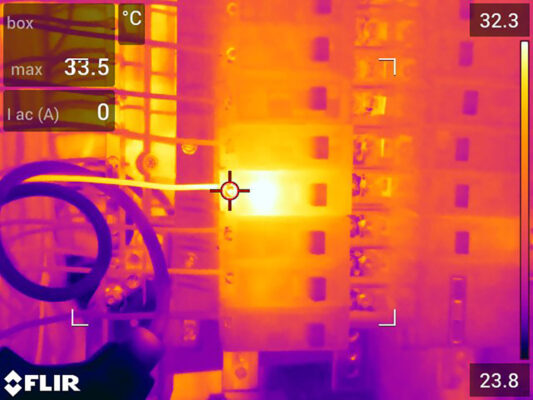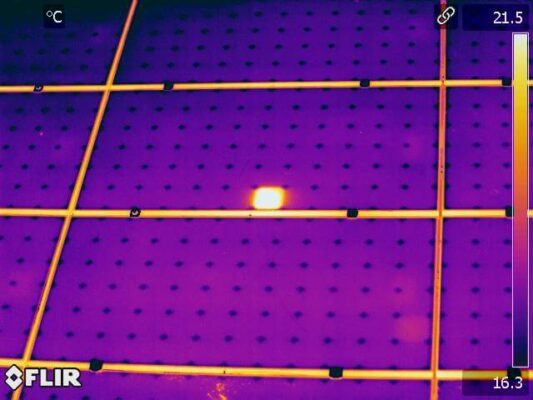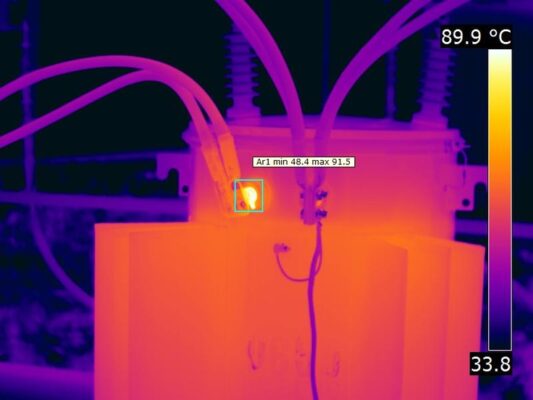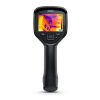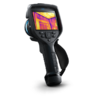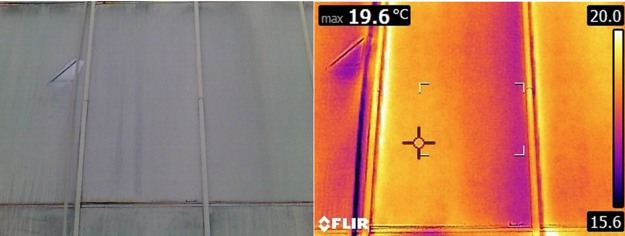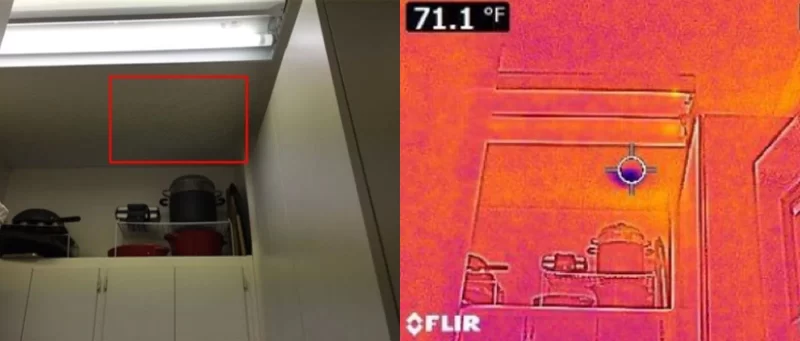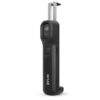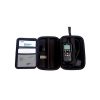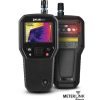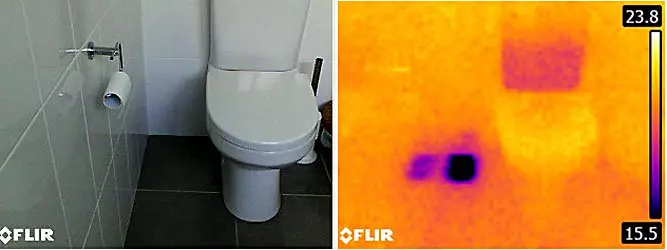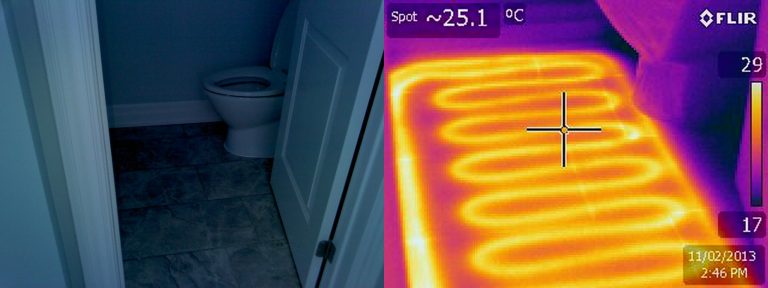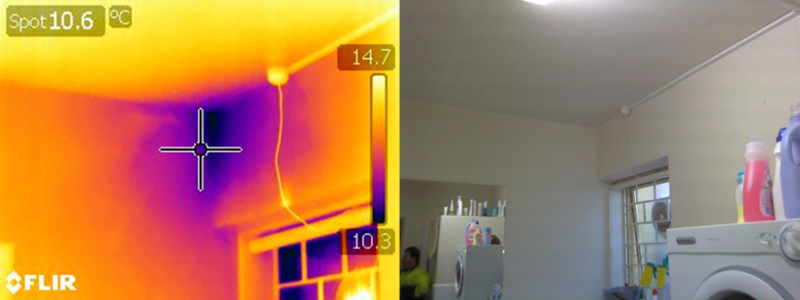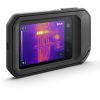Overheating wiring on a switchboard.
Industries
ELECTRICAL INSPECTION
Thermal imaging cameras are powerful and non-invasive tools for monitoring and diagnosing the condition of electrical installations and components. They allow you to inspect the invisible heat and make informed decisions on repair and diagnosis.
With a thermal imaging camera, you can identify problems early, allowing them to be documented and corrected before becoming more serious and more costly to repair.
SWITCHBOARD
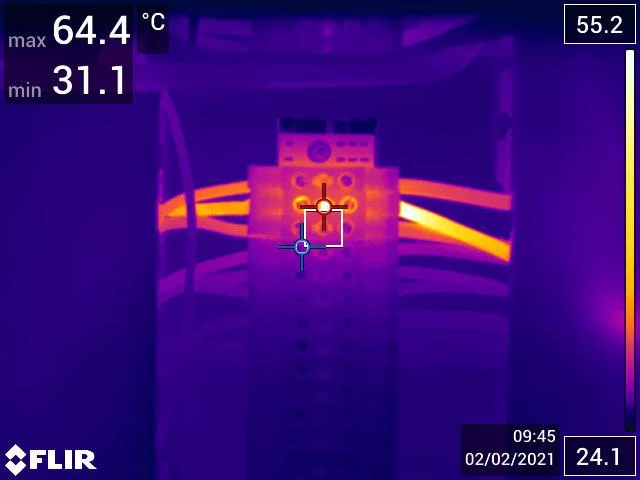
POWER LINES
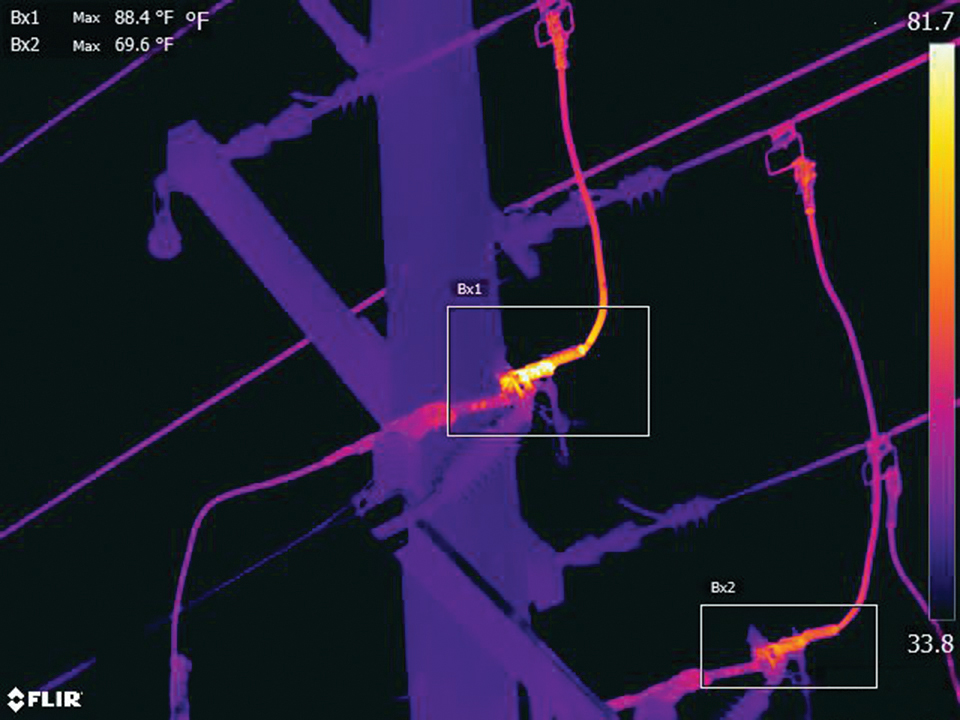
Heat differences on a power line.
The main cause of many issues in electrical systems is excessive current flow or abnormal heating associated with high resistance. Infrared thermography allows us to see these invisible thermal signatures of impending damage before the damage occurs. Normally, parts of electrical energy are converted to heat energy when a current flows through an electrical circuit. However, abnormal high levels of heat can be generated if there is high resistance in the circuit or high current flow, which can cause potential damage to the circuit.
We use high electrical resistance for positive results, such as heat in a toaster or light in a light bulb. However sometimes unwanted heat is generated that result in costly damage. Under-sized conductors, loose connections or excessive current flow may cause abnormally high unwanted heating that result in dangerously hot electrical circuits. Components can become hot enough to melt.
WIRING
A major fault overheating switchboard wiring failure.
SOLAR PANELS
Damaged cell causing lower watt output on a solar panel.
A thermal image that includes accurate temperature data provides the maintenance expert with important information about the condition of the inspected equipment. These inspections should be done with the production process in full operation and in many cases the use of a thermal imaging camera can even help optimize the production process itself.
FLIR Systems offers a wide range of thermal imaging cameras. Whether you use thermal imaging for an inspection of large industrial installations, Commercial switchboards or for an inspection of a fuse box in a domestic residence, FLIR will have just the right thermal imagine camera for you.
ELECTRICAL CAMERA RECOMMENDATIONS
Infratek can assist you in selecting the right camera for your electrical applications and budget. Pixel count is especially important for electrical applications as the industry electrical standard is 320 x 240 pixels and above.
There is currently an expectation from insurance companies that thermal scanning will be carried out on Insured Assets (including Industrial, Commercial and Residential Property) as a part of general maintenance.
Low-volume home electrical scanning
REQUEST A BEST PRICE QUOTEFREE 45-minute startup training included with purchase.
Specs: 240 x 180 pixel resolution and a 33° lens. Note: this pixel count is below the minimum requirement.
Best for: Low volume electrical maintenance and scanning.
Features: It’s more affordable and provides a solid thermal image for basic tasks like detecting overheating circuits, faulty appliances, and wiring issues.
Cons: Not a suitable pixel resolution for insurance electrical work.
Commercial and switchboard scanning
REQUEST A BEST PRICE QUOTEFREE 1-hour startup training included with purchase.
Specs: 320 x 240 pixels and a 33° lens.
Best for: Insurance assessments, switchboard scanning, and general electrical inspections in commercial or residential settings.
Features: 1-Touch Level/Span, save time on your manual adjustments. Changeable box size to detect heat changes in a specific area. Touchscreen with note taking for detailed annotations to images to put in reports.
Large-scale commercial and industrial work
REQUEST A BEST PRICE QUOTEFREE 1.5-hour startup training included with purchase.
Specs: 320 x 240 pixels and a 24° lens.
Best for: Complex commercial, industrial, and government projects.
Features: The E54 and E8 Pro share the same pixel count, however the E54 has a more advanced thermal sensor which provides superior image definition. The E54 has additional advanced features not found on the FLIR E8 Pro, such as a tighter FOV lens, voice recording for hands-free work, emissivity focuser, and enhanced reporting options.
FLIR THERMAL STUDIO PRO SOFTWARE
The FLIR Thermal Studio Suite helps users manage thousands of thermal images and videos from your handheld infrared thermal imaging camera. This subscription software offers the advanced processing features needed for predictive maintenance on critical components, system troubleshooting, and increased productivity.
The pro version of the software is recommended for electrical because it allows advanced reporting capabilities for customers. Infratek can help customers with an automatic custom business template.
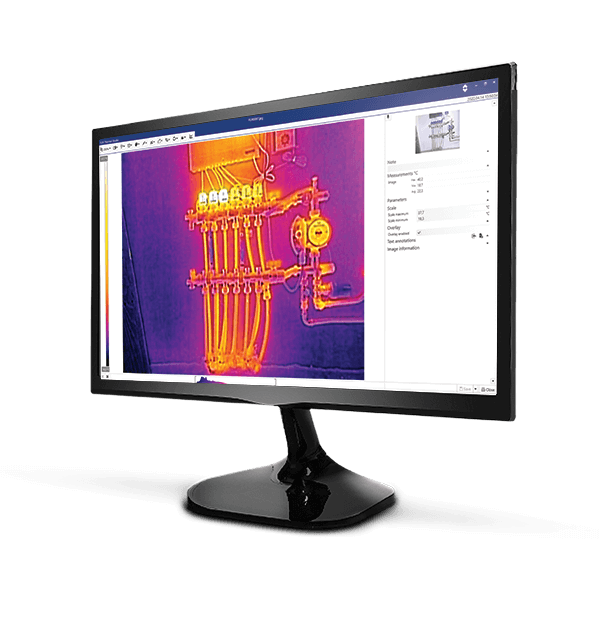
GET FREE TRAINING WITH ALL CAMERA PURCHASES
Bret Jones (Certified Thermographer) has had over 25 years’ experience in providing camera selection, training and consultancy services for the scanning of electrical switchboards and production of high-level reports and customised template design for the FLIR cameras and FLIR Advanced Software.
BUILDING INSPECTION
Thermal imaging technology has become one of the most valuable diagnostic tools for building inspections. Powerful and non-invasive, the use of a thermal imaging camera is ideal choice when monitoring and diagnosing the conditions of buildings and gaining an understanding of the efficiency of a buildings thermal shell.
A thermal imaging camera can identify problems early, allowing them to be documented and corrected before becoming a more serious issue, and as a result, more costly to repair.
INSULATION (ROOF)

Cool patches where there is missing insulation in a roof
AIR LEAKS

Cool temperature under the doorway showing a cold air leak.
To best use the images, the operator will also need to have a keen understanding of how different materials and circumstances influence the temperature readings. These factors include (but are not limited to); thermal conductivity, which is the rate at which a material warms up, emissivity, which is way an object emits or reflects infrared radiation, and reflected temperature, where heat can be reflected from outside sources, such as the operator’s own body heat, or the heat of a light source. For building applications, you need a camera with good sensitivity to detect what are often subtle temperature differences.
DETECT THE INVISIBLE WITH INFRARED
Providing building experts with accurate temperature data, a thermal image supplies important information regarding conditions of the HVAC systems, electrical faults, insulation conditions, moisture ingress, and mould development, all of which are crucial for day-to-day operations.
These and other issues can be spotted at an early stage with a thermal imaging camera. This will help to prevent costly damages and to ensure the continuity of production.
FLIR Systems offers a wide range of thermal imaging cameras. Whether you use thermal imaging for an inspection of large industrial installations, commercial or for an inspection in a domestic residence, FLIR will have just the right thermal imaging camera for you.
BUILDING INSPECTION CAMERA RECOMMENDATIONS
Infratek can assist you in selecting the right camera for your Building applications and budget. We provide full start up training to diagnose various building defects including moisture, thermal shells, and missing insulation. Camera Sensitivity and Lens Angle are often criteria for camera selection for use in Building applications.
Residential Inspection
REQUEST A BEST PRICE QUOTEFREE 30-minute startup training included with purchase.
Specs: 160 x 120 pixel / 54° lens.
Best for: Thorough and detailed assessment of building condition.
Features: Compact design that can be taken anywhere easily, connects to most smartphone and tablets. Good thermal resolution with great thermal sensor for image quality. Moisture meter is strong and suitable for comprehensive building checks
Cons: No humidity sensor in MR60.
Commercial Inspection
REQUEST A BEST PRICE QUOTEFREE 45-minute startup training included with purchase.
Specs: 240 x 180 pixel resolution and a 33° lens. Moisture and humidity meter.
Best for: High-volume commercial and residential inspection with high quality meters.
Features: A strong thermal resolution paired with a separate moisture meter device that measures moisture and humidity, that can fit safely within the E5 Pro case. High image quality and the touchscreen interface makes building inspection easier.
All-In-One Device for Thermal and Moisture
REQUEST A BEST PRICE QUOTEFREE 30-minute startup training included with purchase.
Specs: 160 x 120 pixels / 55° lens.
Best for: Commercial use all-in-one device.
Features: The MR277 features a thermal imager, moisture meter and humidity detection in an all-in-one device.
Cons: Thermal image is worse than standalone thermal imagers due to a lower quality thermal sensor is used in the device. Two separate devices are recommended.
FLIR THERMAL STUDIO SOFTWARE

If you require reporting software for building customers, the FLIR Thermal Studio Standard is suitable. You can create your own reports and change the report layout and use text annotations.
Open images and video from the thermal cameras and add or change measurement functions. Edit the images in the report to change palettes, the image mode and edit images for clarity.
GET FREE TRAINING WITH ALL CAMERA PURCHASES
Bret Jones (Certified Thermographer) has had over 25 years’ experience in providing camera selection, training and consultancy services for the scanning of electrical switchboards and production of high-level reports and customised template design for the FLIR cameras and FLIR Advanced Software.
PLUMBING AND MOISTURE INSPECTION
Water leaks and moisture infiltration can cause serious damage to a house or building and can be difficult to detect until it’s already too late. Using a thermal imaging camera and under the right circumstances, it’s possible to find hidden water and moisture issues without resorting to destructive testing.
There are many sources of building moisture, including humidity (during any season), condensation, pipe leaks, rain and snow, and even people and animals breathing. Usually, a low level of moisture is fine, but leaks or heavy condensation can cause serious problems. A thermal imaging camera cannot “see” moisture in walls, but it can detect subtle temperature differences and patterns that reveal the existence of water.
ROOF LEAK

Moisture shown as cooler temperature
CEILING MOISTURE

Cold spot measurement tools
DETECT THE INVISIBLE WITH INFRARED
Thermal cameras can help locate water leaks and approximate the extent of moisture damage, but identifying a pattern that looks like moisture does not guarantee the presence of water. There are a multitude of reasons you might be seeing a temperature differential besides moisture in the walls. To check what you’re seeing, you should always use a moisture meter to confirm what the thermal camera has detected is actually wet and not simply cold.
Plumbers can use thermal imaging in many areas of their business to help them. While the cameras are not X-ray devices the high sensitivity can often see subtle temperature difference that show up on the outside wall.
When performing a thermal inspection looking for water leaks, be sure to investigate subtle temperature differences. Water is detected with a thermal imager due to small temperature differential and these processes can be affected by weather conditions or interior temperature or humidity. As such we recommend a camera with good sensitivity for moisture problems.
SHOWER STREAKS

Water damage in shower base
INSULATION (ROOF)

Locating insulation
AIR LEAKS

Energy leaks
SOLAR PANELS

Hot water solar panel efficiency
MOISTURE AND PLUMBING INSPECTION CAMERA RECOMMENDATIONS
Infratek can assist you in selecting the right camera for your Moisture and Plumbing applications and budget. We provide full start up training and specialise in the heat analysis for various plumbing applications. Camera Sensitivity and Lens Angle are often criteria for camera selection for use in Plumbing applications.
Residential Inspection
REQUEST A BEST PRICE QUOTEFREE 30-minute startup training included with purchase.
Specs: 160 x 120 pixel / 54° lens.
Best for: Thorough and detailed assessment of moisture and plumbing condition.
Features: Compact design that can be taken anywhere easily, connects to most smartphone and tablets. Good thermal resolution with great thermal sensor for image quality. Moisture meter adequate and suitable for building checks
Cons: No humidity sensor in MR59, see the MR77.
Commercial Inspection
REQUEST A BEST PRICE QUOTEFREE 45-minute startup training included with purchase.
Specs: 240 x 180 pixel resolution and a 33° lens. Moisture and humidity meter.
Best for: High-volume commercial and residential plumbing and moisture inspection.
Features: A strong thermal resolution paired with a separate moisture meter device that can fit safely within the E5 Pro case. High image quality and the touchscreen interface makes building inspection easier.
Cons: No humidity sensor in MR60, see the MR77.
All-In-One Device for Thermal and Moisture
REQUEST A BEST PRICE QUOTEFREE 30-minute startup training included with purchase.
Specs: 160 x 120 pixels / 55° lens.
Best for: Commercial use all-in-one device.
Features: The MR277 features a thermal imager, moisture meter and humidity detection in an all-in-one device.
Cons: Thermal image is worse than standalone thermal imagers due to a lower quality thermal sensor is used in the device. Two separate devices are recommended.
FLIR THERMAL STUDIO SOFTWARE

If you require reporting software for building customers, the FLIR Thermal Studio Standard is suitable. You can create your own reports and change the report layout and use text annotations.
Open images and video from the thermal cameras and add or change measurement functions. Edit the images in the report to change palettes, the image mode and edit images for clarity.
GET FREE TRAINING WITH ALL CAMERA PURCHASES
Bret Jones (Certified Thermographer) has had over 25 years’ experience in providing camera selection, training and consultancy services for the scanning of moisture and plumbing applications and inspections.
MECHANICAL INSPECTION
In many industries, mechanical systems play a critical role in ensuring the smooth operation of machinery and equipment. From manufacturing plants to power stations and HVAC systems, mechanical components are fundamental to keeping production lines running, energy generation stable, and buildings comfortable.
Thermal imaging makes monitoring the health of these mechanical systems easy, and is essential to minimizing downtime, reducing maintenance costs, and ensuring the safety and reliability of operations. Thermal data collected via thermal imaging cameras provides a comprehensive view of the equipment’s condition.
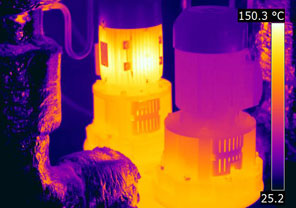
Faulty left pump causing a rise in abnormal heat.

Faulty machinery in a factory identified by heat change.
Motors can also be inspected with a thermal imaging camera. Motor failures like brush contact-wear and armature shorts typically produce excess heat prior to failure but remain undetected with vibration analysis, since it often causes little to no extra vibration. Thermal imaging gives a full overview and allows you to compare the temperature of different motors.
Mechanical systems will heat up if there is a misalignment at some point in the system. Conveyor belts are a good example. If a roller is worn out, it can clearly show an overheating idler bearing in the thermal image so it can be replaced. Typically when mechanical components become worn and less efficient, the heat dissipated will increase. Consequently, the temperature of faulty equipment will increase rapidly before failure.
Other mechanical systems monitored with thermal imaging cameras include couplings, gearboxes, bearings, pumps, compressors, belts, blowers, and conveyor systems. Examples of mechanical faults that can be detected with thermal imaging are:
These and other issues can be spotted at an early stage with a thermal imaging camera. This will help to prevent costly damages and to ensure the continuity of production.
FLIR Systems offers a wide range of thermal imaging cameras. Whether you use thermal imaging for an inspection of large industrial installations, commercial or for an inspection in a domestic residence, FLIR will have just the right thermal imaging camera for you.
MECHANICAL CAMERA RECOMMENDATIONS
Infratek can assist you in selecting the right camera for your mechanical applications and budget. We provide full start up training and specialise in the heat analysis for various mechanical systems. Pixel Count and High temperature are often criteria for camera selection in Mechanical systems.
Low-volume Mechanical Maintenance
REQUEST A BEST PRICE QUOTEFREE 30-minute startup training included with purchase.
Specs: 160 x 120 pixel resolution and a 54° lens.
Best for: Preventative maintenance for friction in mechanical systems (motos, pumps, HVAC systems) and general inspection.
Features: Compact design and touchscreen.
Cons: Lacks image clarity, max 150°C measurement.
Commercial Maintenance
REQUEST A BEST PRICE QUOTEFREE 45-minute startup training included with purchase.
Specs: 240 x 180 pixel resolution and a 33° lens.
Best for: Preventative maintenance to detect mechanical wear and tear, such as overheating, misalignment, or friction. System inspection like HVAC, pump, and compressors.
Features: Strong thermal resolution and image quality, touchscreen interface, area measurement and spot meters.
Complex Industrial Settings
REQUEST A BEST PRICE QUOTEFREE 1.5-hour startup training included with purchase.
Specs: 464 x 348 pixels and a dual 24° + 42° lens.
Best for: Complex mechanical, industrial, and manufacturing environments.
Features: FlexView allows users to toggle between two different FOV with a button, whether you need a broad view for large equipment and then a more focused zoom in. Laser pointer and x4 additional zoom to closely examine.
FLIR THERMAL STUDIO PRO SOFTWARE
The FLIR Thermal Studio Suite helps users manage thousands of thermal images and videos from your handheld infrared thermal imaging camera. This subscription software offers the advanced processing features needed for predictive maintenance on critical components, system troubleshooting, and increased productivity.
The pro version of the software is recommended for mechanical because it allows advanced reporting capabilities for customers.

GET FREE TRAINING WITH ALL CAMERA PURCHASES
Bret Jones (Certified Thermographer) has had over 25 years’ experience in providing camera selection, training and consultancy services for the scanning of mechanical equipment.
PEST CONTROL AND TERMITE INSPECTION
Thermal imagers are an increasingly popular, non-intrusive solution for finding pests or termites in walls and other hidden places. From rodents to possums to termites, many homeowners and building maintenance professionals are using thermal cameras to quickly locate nests and avoid spreading chemicals like insecticides around homes.
Thermal imaging cannot see through walls. Instead, thermal cameras detect temperature differences on the surface of a wall that is caused by something on the other side. For instance, a thermal camera won’t pick up a animal moving through a wall but could detect a animal resting in one spot like a possum or a wasp / bees nest that has been generating heat for a long period of time and caused the outer wall to warm up.
PEST DAMAGE INSIDE WALLS

Pest damage will emit different heat, which will show up as damage inside walls.
If a large heat source like a nest isn’t obvious, sensitive thermal cameras may be able to detect irregular heat patterns, moisture, and other signs of damage that indicate the presence of a pest, like missing insulation or holes in walls that indicates an entry point. Understanding what patterns to look for requires training and practice, as it’s easy to incorrectly interpret an image.
POSSUM IN ROOF

A possum sitting inside a roof.
MUD TRACKING

Termite mud tracking inside a wall.
PEST BEHIND BED

A pest emitting heat behind a wall.
BEES NEST

A bees nest inside the corner of roof.
Thermal cameras take the guesswork out of pest detection, saving inspectors hours of work, helping identify the exact location of nests, and minimizing the amount of damage needed to remove them.
PEST CONTROL AND TERMITE CAMERA RECOMMENDATIONS
Infratek can assist you in selecting the right camera for pest inspection. Camera sensitivity is crucial for this application, as the temperature differentials are usually very low.
Low-volume, routine building inspection
REQUEST A BEST PRICE QUOTEFREE 45-minute startup training included with purchase.
Specs: 240 x 180 pixel resolution and a 33° lens, and 320 x 240 pixels and a 33° lens.
Best for: Low volume pest inspection, generally as a part of a general building inspection.
Features: It’s more affordable and provides a solid thermal image for basic tasks like seeing pests in walls.
Cons: Not a strong enough thermal camera for pest control only.
Commercial inspection
REQUEST A BEST PRICE QUOTEFREE 1.5-hour startup training included with purchase.
Specs: 320 x 240 pixels and a 24° lens.
Best for: Commercial pest inspections, can show most pest control applications with strong thermal imaging.
Features: Stronger thermal sensor that the Professional camera range. 1-Touch Level/Span, save time on your manual adjustments. Changeable box size to detect heat changes in a specific area. Touchscreen with note taking for detailed annotations to images to put in reports. Voice notations available. Rotatable lens for easy MSX enhancement.
Large-scale commercial with termite mud tracking
REQUEST A BEST PRICE QUOTEFREE 1.5-hour startup training included with purchase.
Specs: 320 x 240 pixels and a 24° lens, optional 14° or 42° lens available.
Best for: Large-scale commercial and complex pest inspection.
Features: The E76 is a step up from the E54 with all the same features, but with the ability to interchange lenses depending on what inspection is being completed. This will provide a larger range of inspection to be done more clearly and thoroughly.
FLIR THERMAL STUDIO PRO SOFTWARE

If you require reporting software for pest control or termite customers, the FLIR Thermal Studio Standard is suitable. You can create your own reports and change the report layout and use text annotations.
Open images and video from the thermal cameras and add or change measurement functions. Edit the images in the report to change palettes, the image mode and edit images for clarity.
GET FREE TRAINING WITH ALL CAMERA PURCHASES
Bret Jones (Certified Thermographer) has had over 25 years’ experience in providing camera selection, training and consultancy services for the scanning of electrical switchboards and production of high-level reports and customised template design for the FLIR cameras and FLIR Advanced Software.
EQUINE AND VETERINARY INSPECTION
Infrared is an excellent tool to uncover any health issues in animals such as horses. thermal imaging cameras assist in the equine medicine field. With the benefit of early detection, thermography can be used to find underlying health problems such as areas of infection or ligament and soft tissue damage which may show as inflammation (heating). Finding these problems early means preventative treatment can begin which avoids the risk of further injury and helps in the animals recovery.
HORSE FOOT

HORSE BODY

HORSE LEG

HORSE BODY CLOSE

People who often work with horses usually use their hands to try and feel the animals for any subtle temperature changes that could indicate inflammation, infection or other problem. Like human skin, horse skin feels hot to the touch if there’s an underlying issue such as an infection or muscle strain. This has limitations, however, as humans can only feel large temperature changes. An easier way is to use thermal imaging camera which better than 0.05-0.06 sensitivity (or better) that can detect small / subtle temperature changes.
The demand for thermal imagery for animals is well established. Thermal imaging enables early detection of problems and early intervention with the appropriate veterinary treatment. – saving owners (particularly equine) time and money and reducing the likelihood of their animals discomfort.
- FLIR cameras = E6 Pro, E8 Pro, E54, and E76.
- Trainer – Bret Jones (Certified Thermographer and Qualified Civil / Structural Engineer and Architect) – Bret has had over 25 years’ experience in providing camera selection, training and consultancy services for the scanning for Equine and Veterinary applications.
PEST CONTROL AND TERMITE CAMERA RECOMMENDATIONS
Infratek can assist you in selecting the right camera for equine and veterinary inspection. Camera sensitivity is crucial for this application, as the temperature differentials are usually very low.
Low-volume inspection
REQUEST A BEST PRICE QUOTEFREE 45-minute startup training included with purchase.
Specs: 240 x 180 pixel resolution and a 33° lens, and 320 x 240 pixels and a 33° lens.
Best for: Low volume equine inspection, generally as a part of a general animal health inspection.
Features: It’s more affordable and provides a solid thermal image for basic tasks like seeing overall animal temperature.
Cons: Not a strong enough thermal camera for other applications.
Commercial inspection
REQUEST A BEST PRICE QUOTEFREE 1.5-hour startup training included with purchase.
Specs: 320 x 240 pixels and a 24° lens.
Best for: Commercial equine and veterinary inspections, can show most equine and veterinary applications with strong thermal imaging.
Features: Stronger thermal sensor that the Professional camera range. 1-Touch Level/Span, save time on your manual adjustments. Changeable box size to detect heat changes in a specific area. Touchscreen with note taking for detailed annotations to images to put in reports. Voice notations available. Rotatable lens for easy MSX enhancement.
Large-scale commercial inspection
REQUEST A BEST PRICE QUOTEFREE 1.5-hour startup training included with purchase.
Specs: 320 x 240 pixels and a 24° lens, optional 14° or 42° lens available.
Best for: Large-scale commercial and complex equine and veterinary inspection.
Features: The E76 is a step up from the E54 with all the same features, but with the ability to interchange lenses depending on what inspection is being completed. This will provide a larger range of inspection to be done more clearly and thoroughly.
FLIR THERMAL STUDIO PRO SOFTWARE

If you require reporting software for pest control or termite customers, the FLIR Thermal Studio Standard is suitable. You can create your own reports and change the report layout and use text annotations.
Open images and video from the thermal cameras and add or change measurement functions. Edit the images in the report to change palettes, the image mode and edit images for clarity.
GET FREE TRAINING WITH ALL CAMERA PURCHASES
Bret Jones (Certified Thermographer) has had over 25 years’ experience in providing camera selection, training and consultancy services for the scanning of electrical switchboards and production of high-level reports and customised template design for the FLIR cameras and FLIR Advanced Software.

